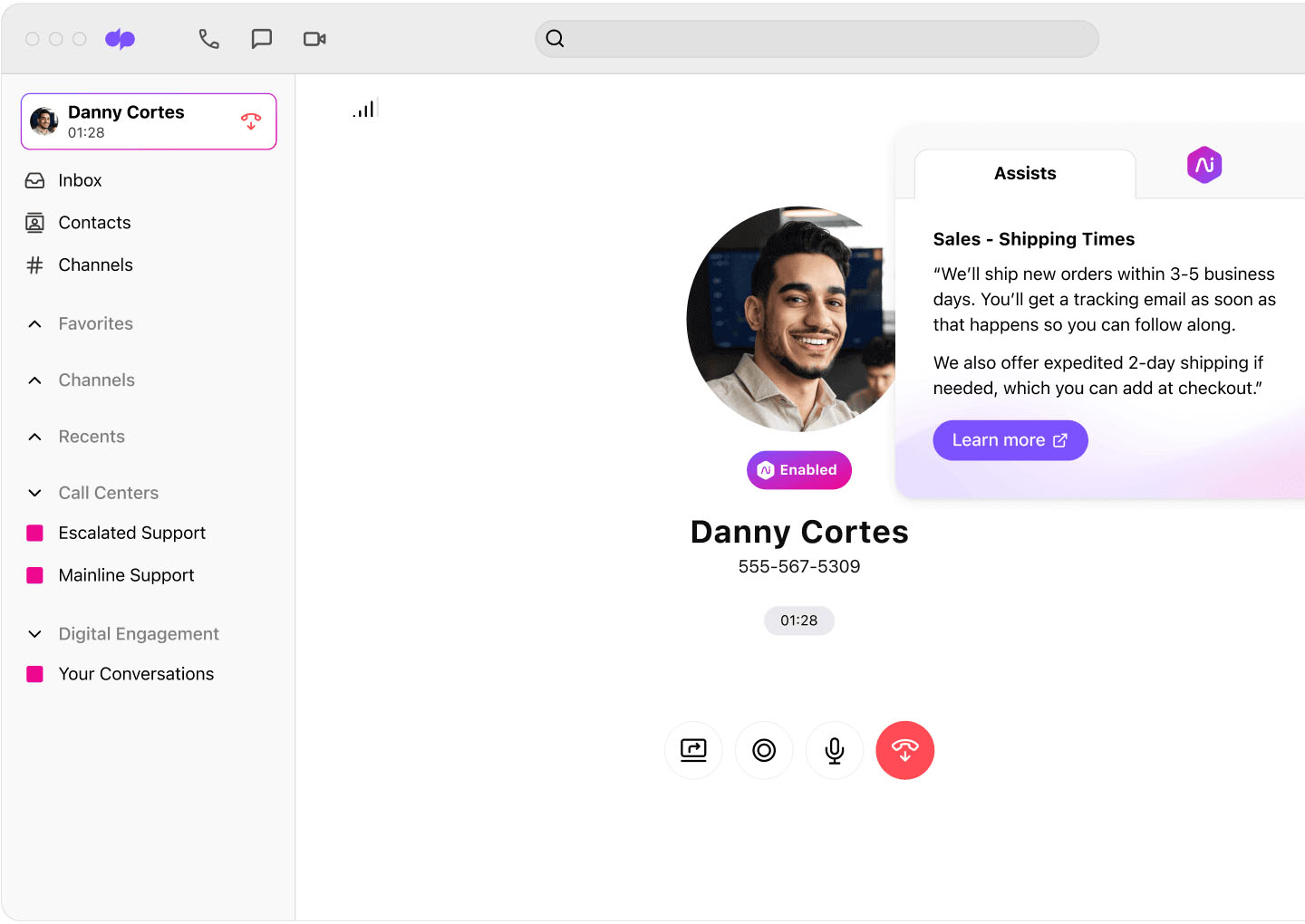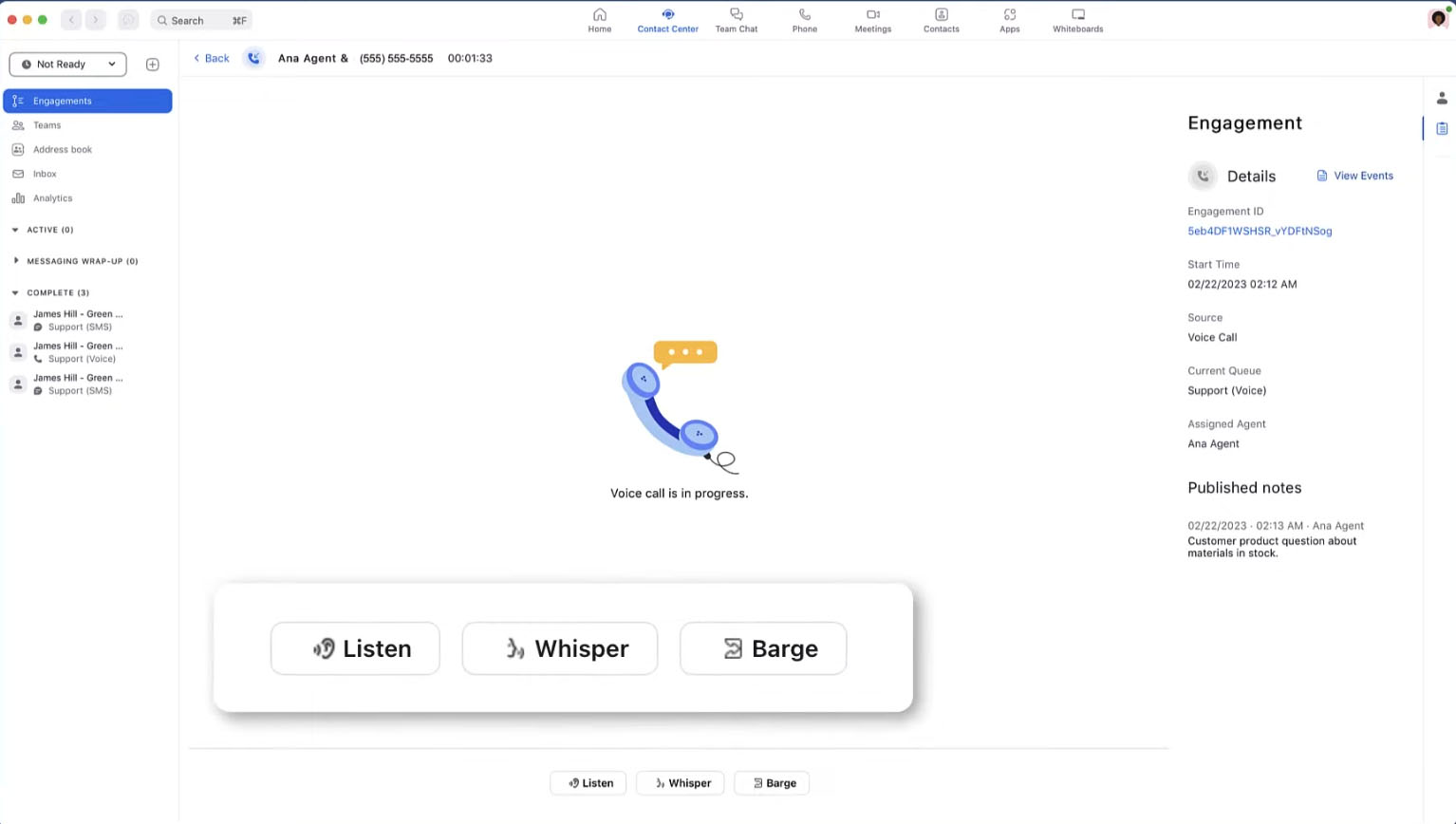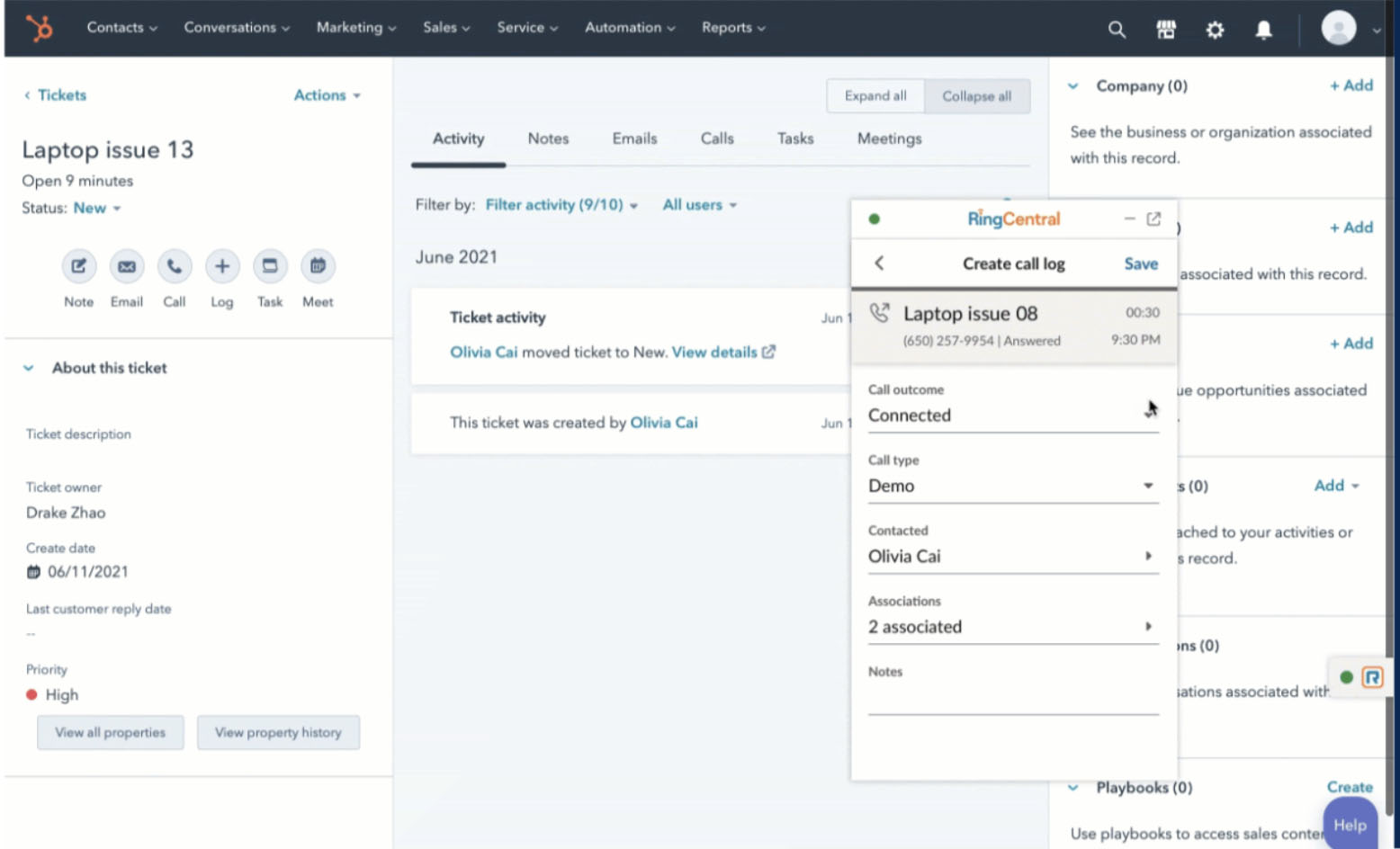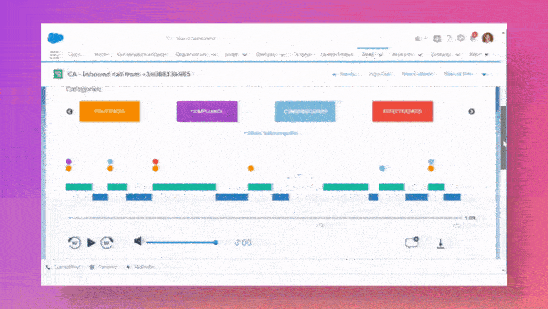First call resolution (FCR) is a key call center metric measuring how well the agents answer customers’ needs on the first contact. The benchmark average for the FCR rate is 70%, though this percentage also depends on the industry. A high FCR rate reflects excellent customer experience and agent productivity. To achieve this, learn how to improve first call resolution by adopting strategies like creating a call center knowledge base, implementing skills-based call routing, and training agents regularly.
1. Create a Call Center Knowledge Base
It gets difficult for agents to resolve customer issues quickly because of the lack of knowledge or access to important information. This is why part of the strategy for how to improve first call resolution is creating a robust call center knowledge base, a centralized data repository that contains frequently asked questions (FAQs) and step-by-step troubleshooting guides.
To build a powerful database, study the most common customer inquiries and identify the products and services clients often call about. Answer each one comprehensively and in a way an agent will explain in an actual conversation. This should serve as a template for how to answer professionally. Ideally, your database should have search functionality to allow agents to easily pull the information they need while on an active call.
2. Implement Skills-based Call Routing
Skills-based routing distributes calls to agents who are most qualified to answer concerns. To enable this type of routing, call center systems require you to identify the skills necessary to accommodate calls and rank the agents based on their competencies within those skills. Then, the platform automatically assigns calls to agents ranked higher in specific competencies.
When customers are matched with service representatives equipped with the right knowledge on the matter, there’s a higher chance that the inquiry will be resolved not only at the first call but also within a few minutes. This shortens call queues and makes the overall call center operations more efficient.

Determine agents’ skill levels and let 8×8 match customers with the right service representatives. (Source: 8×8)
8×8 Contact Center features skills-based routing as part of its call distribution system. It lets you assign skill levels to each customer service representative. The skill levels are shown as numerical values, from 10 to 100, with an increment of 10. Ten is the lowest skill level value, while 100 is the highest.
Aside from a robust skills-based routing system, the platform offers an intelligent interactive voice response (IVR) that makes matching customers to agents more accurate. The provider features five subscription plans with custom pricing.
3. Listen Actively to Customers
Active listening means staying focused on what the customer is saying and understanding their concerns thoroughly. When you have an accurate grasp of the issue, you’re more likely to come up with helpful fixes. On the flip side, you’re more inclined to drag the conversation longer than it should be and end up giving irrelevant solutions when you don’t intentionally listen to your customers.
For this reason, how to improve first contact resolution involves being in the moment, concentrating on what the customer says, and being sensitive to the client’s mood and tone. This allows you to respond more precisely.
By extension, you must learn how to ask clarifying questions to further understand what needs to be done. Some first call resolution phrases agents should use include, “From my understanding, you’ve been experiencing this… Is that correct?” or “You said you were… Did I get that right? Feel free to correct me if I misunderstood anything.” Repeating or paraphrasing customers’ statements makes it easier to recognize the real issue and provide better solutions.
4. Maximize Agent Assist Powered by Artificial Intelligence (AI)
To further improve the agent’s ability to answer questions accurately and professionally, maximize your phone system’s agent assist technology. Agent assist offers real-time guidance for service representatives, providing answer recommendations or showing relevant information pulled from knowledge hubs. The prompts from this AI-powered feature are most beneficial for new agents, giving them a confidence boost as the guides provide correct answers to queries.

Refer to Dialpad’s AI Agent Assist when answering customer concerns. (Source: Dialpad)
Dialpad Contact Center features AI-powered Agent Assist, displaying professional, carefully curated spiels for different types of customer concerns. The real-time assist cards are triggered by preset phrases.
Once triggered in a call, notes appear in the Moments section of the Call Review, helping you track specific topics or sentiments efficiently. Its monthly subscription starts at $95 per user.
5. Revisit Company Policies & Procedures
Sometimes, rigid company policies and procedures prevent service representatives from fully resolving concerns and granting their requests. Some inquiries, like customer refund requests, need to be transferred to someone of higher authority. When you receive multiple escalation concerns like this, the first call resolution rate declines.
The best way to handle this issue is to revisit company policies and procedures. See if it’s possible to be flexible in managing such sensitive concerns, giving agents the authority to decide based on a set of criteria. Provide additional training for handling those types of requests to ensure compliance with company standards and procedures.
6. Join the Conversation, if Necessary
Part of the best first call resolution tips is enabling managers to participate in active calls and address customers directly. Given that they’re seasoned professionals and subject matter experts, they’ll be able to answer queries faster and grant requests since they have the authority.
One of the most common call center features is the call monitoring system, equipped with call barge and takeover tools. Barge allows team leaders to join the conversation to help agents facilitate faster customer service. Takeover, on the other hand, lets managers take control of the call and remove the agent.

Use Zoom’s barge feature to talk to customers directly. (Source: Zoom Contact Center)
Zoom Contact Center is an omnichannel contact center platform with a robust call monitoring system. It has a call listening tool, allowing supervisors to observe ongoing calls. Its call whisper lets managers speak to agents without the customer knowing they’re coaching in real time.
The barge feature enables them to join a conversation between an agent and a customer, essentially forming a three-way call, so they can answer customer inquiries directly. Subscribe to this platform for only $69 per user, monthly.
7. Train Agents Regularly
Learning how to improve first call resolution involves empowering service representatives through consistent training. Develop more skilled agents ready to take on a range of customer concerns. At the very least, they should be able to master product knowledge—understanding the features, benefits, and applications of what you offer.
Other skills your agents must have to improve first call resolution include problem-solving, clear communication, and multitasking. At the beginning of the training, be clear about your objectives so participants know what’s expected of them.
To evaluate the level of learning, use call simulations, which may involve a real person or a software solution. The virtual dialogue type of simulation includes preprogrammed questions designed to have agents apply what they learned from the sessions.
8. Connect Call Center Systems to Other Business Tools
It’s difficult for agents to resolve customer concerns when they don’t have the proper context of inquiries. Lack of access to the customer’s full history, including previous transactions, products inquired and purchased, and support requests, keeps representatives from meeting clients’ needs at the first contact. Given that, make customer information readily available for agents.
More importantly, keep such details within one platform so team members won’t have to switch between different apps, as this could make call handling time longer and frustrate customers. To improve first call resolution, connect your phone system to other business tools like customer relationship management (CRM) apps. This provides agents with a 360-degree customer view that helps them resolve customer issues effectively.

Connect RingCentral to HubSpot to see customers’ ticket activity conveniently. (Source: RingCentral)
RingCentral is among the top voice-over-internet-protocol (VoIP) phone systems for robust integrations, as it connects with over 300 third-party apps. This includes CRM platforms such as HubSpot, Salesforce, Zoho CRM, and Microsoft Dynamics 365. With this, you’ll easily have call management capabilities within your CRM account, making referring to customer information convenient. As mentioned in our RingCentral review, the platform’s entry-level subscription costs $30 per user, monthly.
9. Ask Key Questions Before Ending the Call
Agents should remember that a call can only be considered complete when the customer says so. Before hanging up, ask key questions to confirm if their concern has been addressed. These are some call closing questions you must have in your spiels:
- Did I fully resolve the issue we discussed?
- Is there anything else I can help you with?
- I’m glad that we were able to address your concern. Will that be all for you today?
10. Identify the Causes of Repeat Calls
Also included in the list of top first call resolution best practices is analyzing the root causes of repeat calls. You’ll be able to draw more strategic decisions in terms of agent training, call routing, and script development when you know exactly why concerns aren’t resolved in the first contact. These are some action steps to take to identify the causes of repeat calls:
- Revisit and analyze call records
- Collect customer feedback through post-call surveys
- Encourage agents to take down notes after phone calls
- Refer to activity histories in CRM customer profiles
- Observe active calls via the listening tool
As you analyze information, pay attention to which types of queries aren’t resolved at the first call and why some requests are escalated to managers or transferred to other departments.

Read Vonage’s conversation transcript as you analyze calls. (Source: Vonage’s YouTube Page)
Vonage Contact Center is equipped with Conversation Analyzer, a tool that features a post-call transcription. In our Vonage Contact Center review, we noted how beneficial it is for finding a particular topic or theme when examining conversations. As you analyze the root causes of repeat calls, input keywords like “speak to the manager” in the tool’s search functionality to learn more about unresolved first calls and understand their full context.
The contact center system analyzes calls according to relevant business categories, namely politeness, compliance, communication, and effectiveness. This gives you a sneak peek at the agent’s performance, which further informs your analysis of first call resolution. Vonage’s subscription plans come with custom pricing.
Frequently Asked Questions (FAQs)
When agents resolve concerns on the first call, they ultimately improve the customer experience and call center efficiency. These are the specific ways FCR benefits your business:
- Better customer retention: Frustrated customers are more likely to switch to companies that would serve them better and make transactions hassle-free. If you’re able to address customer queries at the first contact and clients don’t have to keep following up for the same requests, there’s a higher likelihood that they will continue using your products and services and remain loyal to your company.
- More upselling and cross-selling opportunities: Resolving customer queries efficiently puts you in a better position to upsell or cross-sell products and services. Since you already gained customer trust, they’re more inclined to consider other solutions.
- Lower operational costs: First call resolution means a reduced number of follow-up calls. Thus, you won’t need additional agents to accommodate the influx of inquiries.
- Satisfied agents: As much as customers are happy to have concerns resolved efficiently, service representatives are likewise pleased to close customer tickets at the first call. It affirms their work excellence and, more importantly, allows them to move forward with other customer inquiries. With a motivated team of agents, you’re more likely to see improved call center efficiency.
The industry standard for first call resolution varies depending on the industry. But generally speaking, it’s at 70%, which means most businesses solve 70 out of 100 customer inquiries at the first call. Software-as-a-service provider Fullview presents specific benchmarks for different industries:
- Call Center: 71%
- Technology: 65%
- Financial: 71%
- Insurance: 76%
- Retail: 78%
- Energy: 71%
To calculate the first call resolution rate for a period of time, take the total number of cases resolved at the first contact and divide it by the total number of cases. Convert it to a percentage by multiplying the quotient by 100. In summary, the formula for first call resolution is:
FCR | = | Total Number of Cases Resolved at the First Contact | ✕ | 100 |
Total Number of Cases |
Bottom Line
First call resolution is an important call center metric that gauges customer satisfaction and agent productivity. To improve FCR, businesses must configure their call center software solutions to readily provide key customer and company information to agents, accurately match customer queries to the right service representatives, and enable call monitoring and analysis.
Moreover, you must offer effective training aimed at enhancing agent communication skills. Learn more about the key call center metrics to keep an eye on to maintain operational efficiency.